-
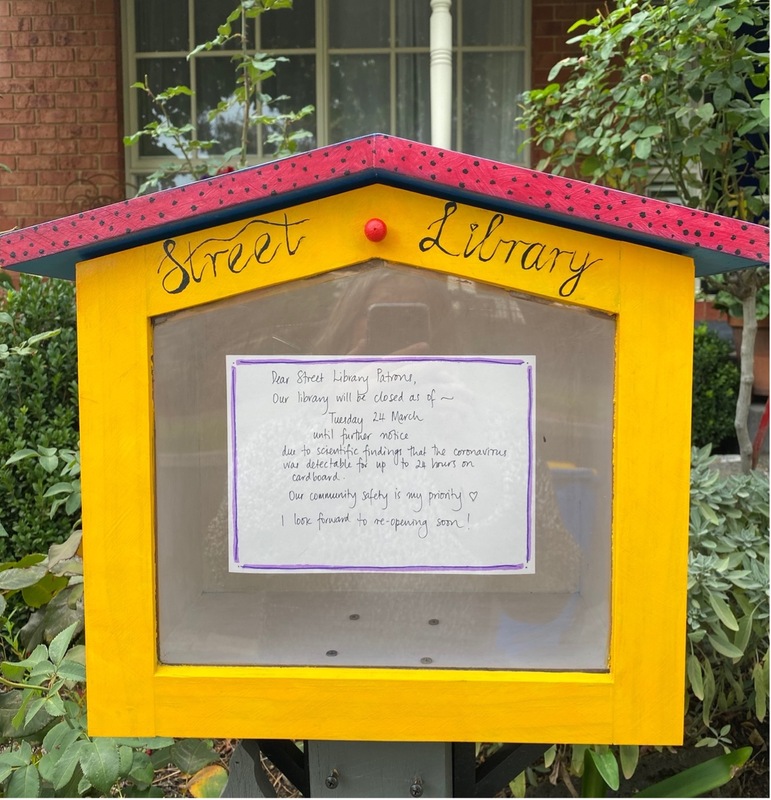
2020-03-24
(HIST30060) This is a photo of the closed sign my Mum and I put on our street library after we found out about the pandemic in 2020. It reads:
Dear Street Library Patrons,
Our library will be closed as of Tuesday 24 March until further notice due to scientific findings that the coronavirus was detected for up to 24 hours on cardboard. Our community safety is my priority <3 I look forward to re-opening soon!
We made the street library in 2019 so the community could share our love of books. People could take a book, read it and, if they wanted to, put their favourite book back in. It made us sad to close the street library but after the lockdown was over we started it back up again!
-
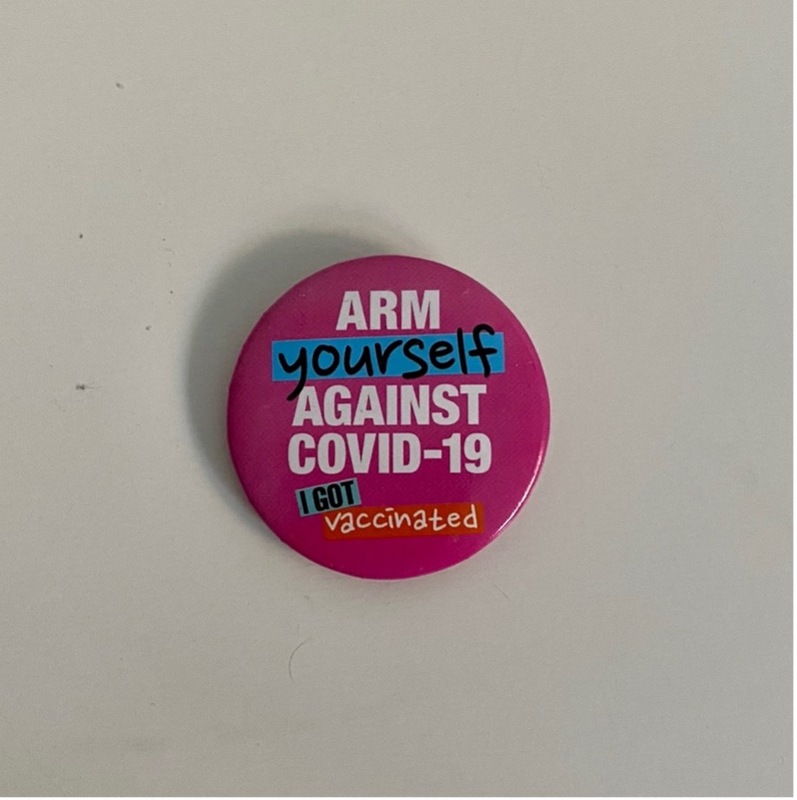
2021-10-01
(HIST30060) This is a photo of the badge I received after getting my second dose of the Pfizer vaccine. I currently work as a medical receptionist at a GP clinic that has been running vaccination sessions – this is where I was vaccinated and received the badge. The badge reads: ‘Arm yourself against COVID-19…I got vaccinated’. The badge is colourful and eye-catching, and the pun is…punchy. I think it acutely captures the typography, tone and gist of the recent government advertisements urging people to get the vaccine.
-
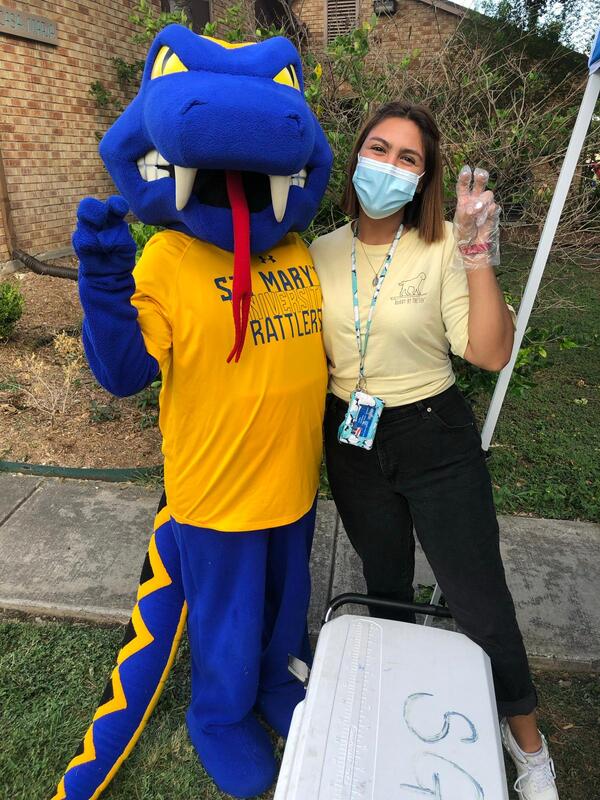
2021-08-24
Burgers with the Brothers is a tradition at St. Mary’s University. Once a year the students and the Marianist brothers get together to build community and enjoy some delicious burgers made by the brothers and students. For 2021 authorities made it possible after a year without it and made students and brothers able to make memories once again. The Marianist Leadership Program made also a contribution to Burgers with the Brothers. MLP is an organization of servant leaders that are willing to help wherever help is needed. As a student doing service with the Marianist Leadership Program, I am happy with how the event took place. As students, we were able to connect with the brothers and other students while using facemasks and gloves to serve the burgers, give out chips and water bottles. I am thankful to live experiences like this one because even if it is not like it used to be, it helps St. Mary’s Spirit be alive and be in continuous connection with the university. Burgers with the Brothers is a very special event for students and brothers to connect and have a little bit of fun on campus. Because it is a tradition is very important for older generations and younger generations to feel the community and experience the Marianist environment.
-
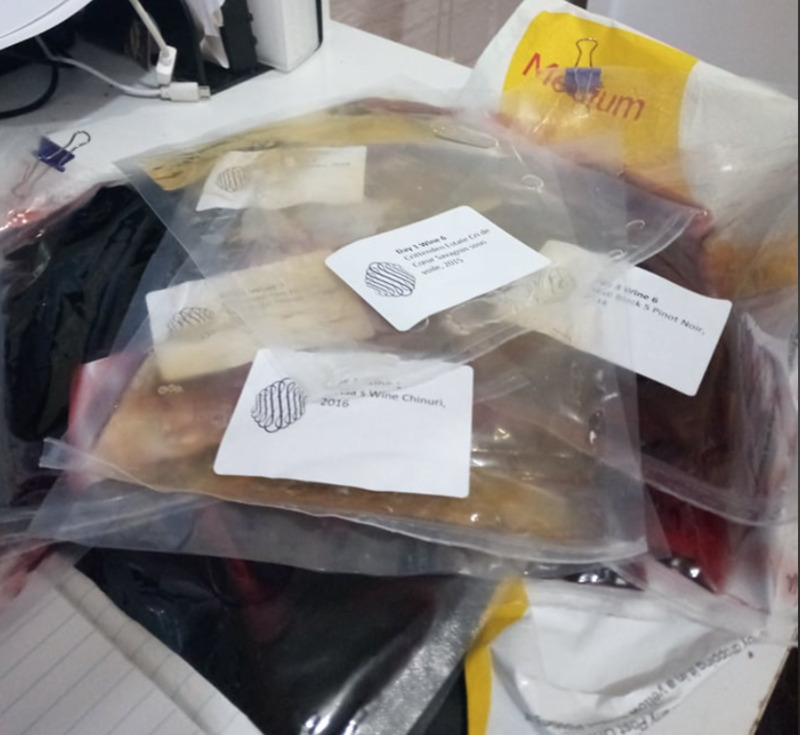
2021-09-07
This year, I completed an intensive subject called Wines of the World at university. It was postponed many times due to restrictions, and the subject coordinators eventually decided that they would have to host the course entirely online. A key component of the subject was wine tasting, and this photo shows how this was made possible at home. Wine tastings in sous vide bags were posted to each student's house, a quite exciting and novel experience. This photo thus reflects how educators have had to be flexible around restrictions, and come up with new ways to facilitate learning.
-
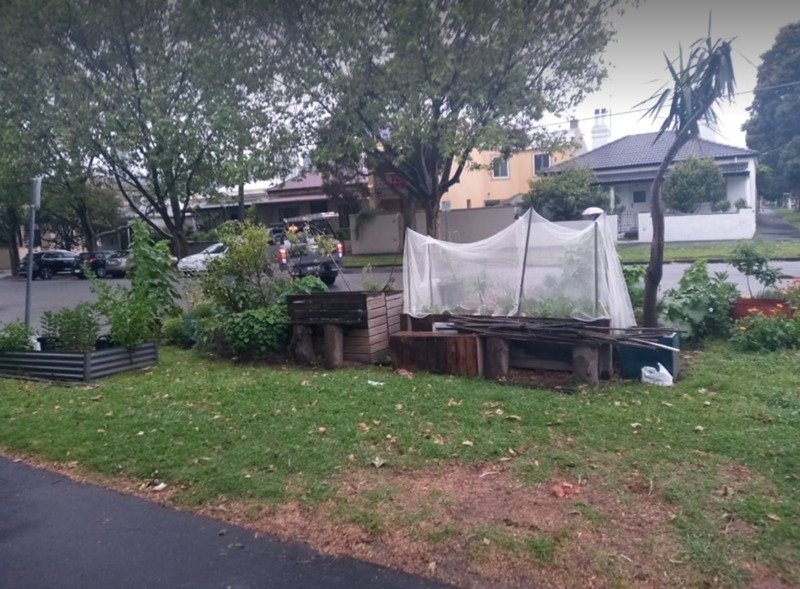
2021-10-07
This is a photo of a community garden at a park very close to me. Although this project existed before the pandemic, it has flourished much in this time to become a beautiful large garden with many different plants. I think this reflects some of the positive effects of the pandemic, as for some people, it gave them the chance to focus on things they might not normally have. Community engagement and connection in this way has provided hope for many people during this time.
-
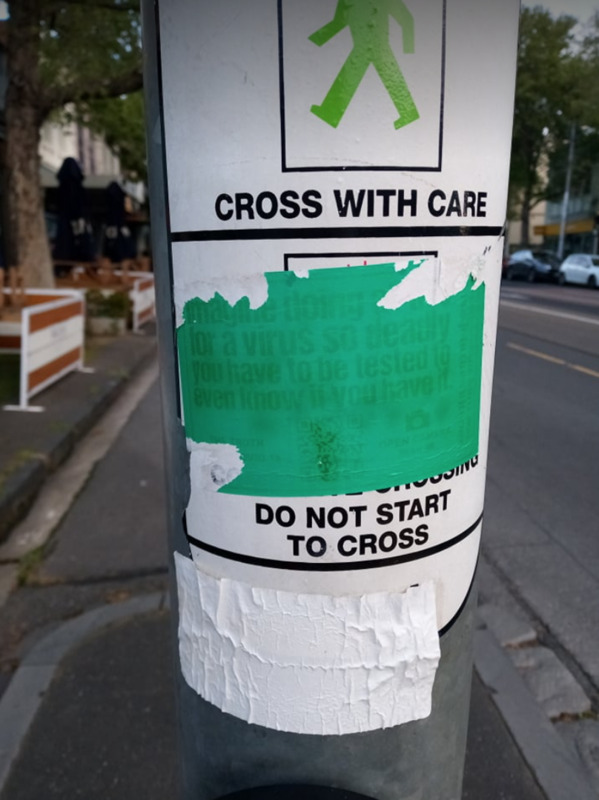
2021-09-10
This is a sticker I saw on the street that says 'imagine having a virus so deadly you have to be tested to even know if you have it.' It appears as though someone has attempted to peel it off. I think this image reflects rather well the differing opinions and theories about the origins and seriousness of the virus. That someone has attempted to remove it signals the rather heated and emotional nature of the debate, as those who question what we have been told about the virus are regularly labeled 'conspiracy theorists.' In my view, that there is differing opinions on the virus, no matter how controversial, is part of the free speech that makes this country so great, and that we can debate these issues somewhat freely should not be taken for granted.
-
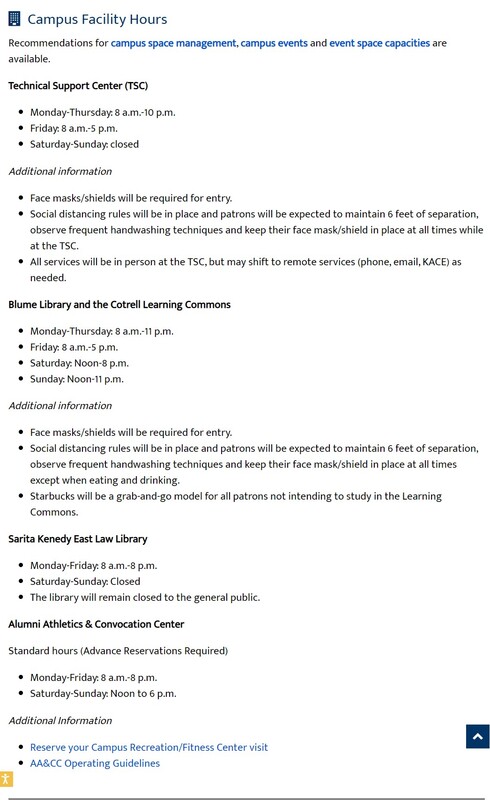
2021-10-27
The pandemic brought a lot of changes in our work environments and that includes the changes in business hours. At St. Mary's University, these screenshots show the hour alterations to on-campus facilities, since January, and the new rules that are to be followed by all.
-
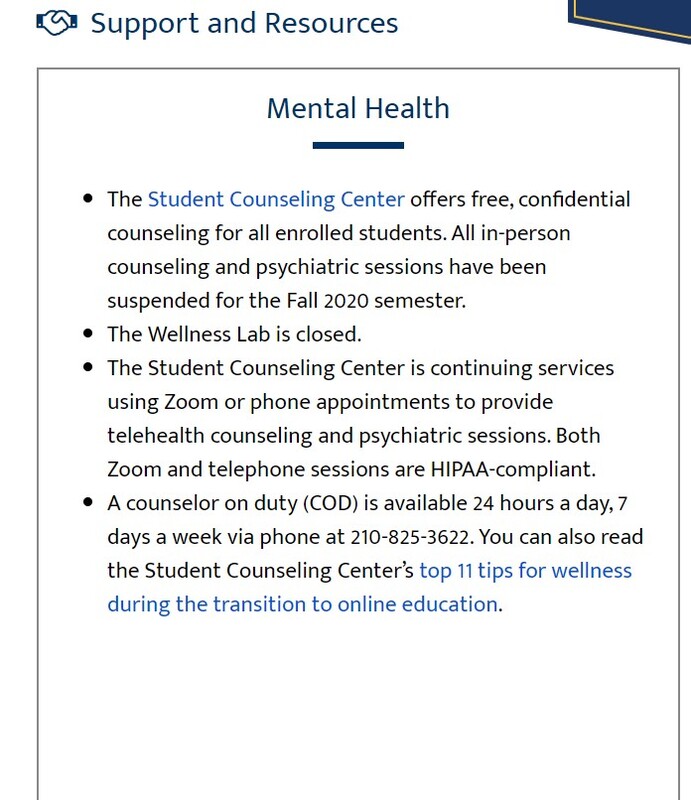
2021-10-27
The pandemic no doubt brought a lot of mental stress into student's life. The result of this stress was the mental health support, via St. Mary's University, reaching out to the student population, as well as the ministry aiding in the mental health of students.
-

2021-10-27
The Student Emergency Fund at St. Mary's was part of an economic relief through the CARES act; where students got financial support via the university. I personally used this fund to help pay for school and basic necessities, like food and bills. It was a relief that students, like myself, were able to obtain this financial support throughout the pandemic and it's still available for all students.
-
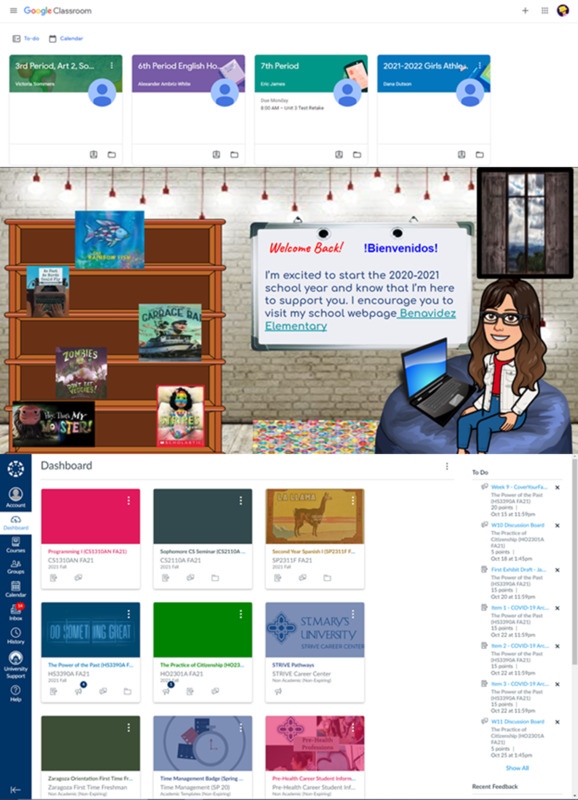
2020-08-11
Online was the new way of providing lessons, assigning classroom activities, and laying out information for students across all ages. Sites like google classroom, canvas, blackboard, and seesaw suddenly became teachers and professors only way of providing students with a "classroom". In the first picture we see an example of an elementary school platform, in the next image is a middle school layout, and the final image is of the new college format. All three platforms provided students with a visual way to remain in contact with their educators in a time where we couldn't meet. They were our way of adjusting to the new situation we were all stuck in. However, despite providing us with the benefits of being connected without having to meet in person, there were still a few shortcomings. Because of the lack of in person class we couldn’t form connection with each other. That was a struggle for kids and teachers/professors alike. There remained a barrier between each other.
-
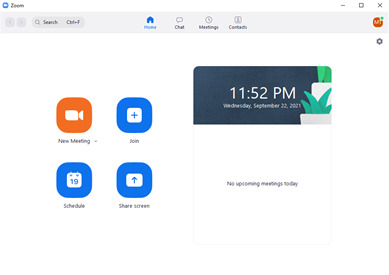
2020-08-11
From my senior year in high school to my Freshman year in college, the way I would attend class had drastically changed. However I wasn't alone in this change. Students, teachers, and professors all around the world found themselves having to adapt to a new form of teaching. A tool that we all had to learn to use was zoom. Unable to attend in person class led to the development of this so-called new “classroom”. Across the world we would now find ourselves logging in to zoom on our computers to attend class. For many of us, me included, the college experience had simply become waking up in my room.
-
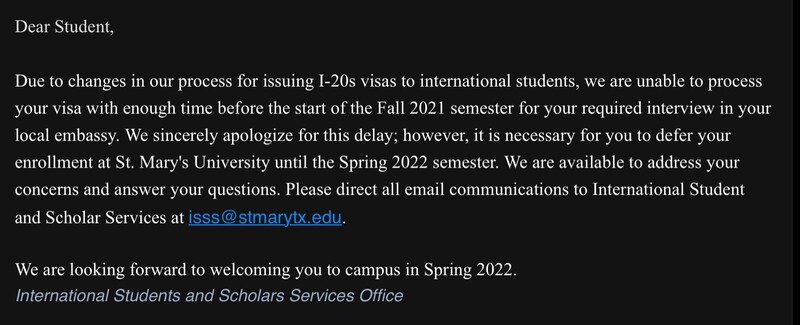
2021-08-02
In the Center of International Programs, during Summer 2021, some decisions had to be made in the office. Due to internal changes, some applications could not be processed, and I-20s could not be developed. Between 10 to 20 undergraduates and graduate students had to be deferred to have more time to issue their visas. This impacted students as some had already made arrangements to come and each case had to be taken into consideration and also be taken personally. The Center of International Programs has over 20 students preparing to go to the university by Spring 2022.
-
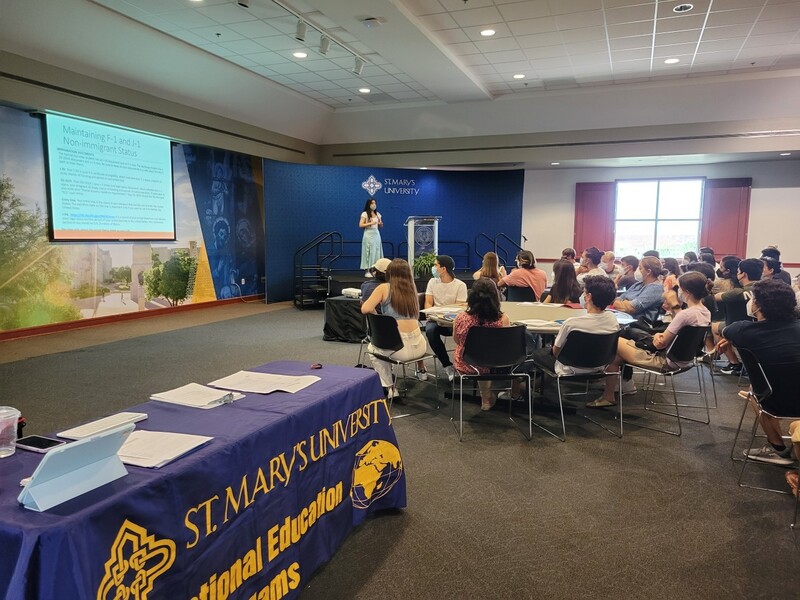
2021-08-09
On August 9th, 45 students (approx.) came to the first international student orientation. During the session, they explained how to maintain the visa status, more information about working in the university, and health recommendations and guidelines. They were also asked to leave their documentation for the following scanning and complete some forms during the session. This session was the first one after COVID-19 appeared in the US.
-
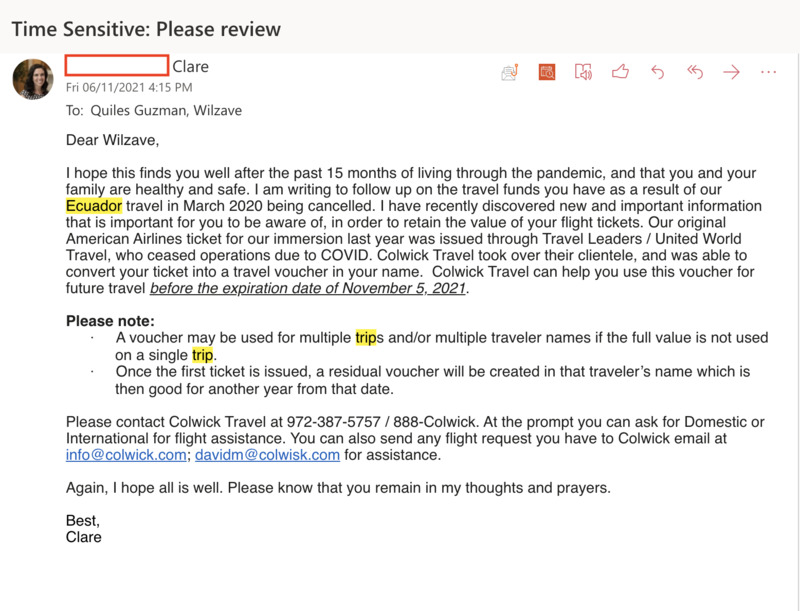
2021-06-11
Each of the members of the flight to Guayaquil, Ecuador, was deeply connected with the purpose of traveling which was to be present with the neighbors in Ecuador. Some of us thought that the main purpose of the course, Empower: Ecuador, was to travel. To some extent it was, but after the trip cancelation, we realized there was also another greater purpose. The greater purpose was to grow in vulnerability, spirituality, and in self-reflection. To learn how to be vulnerable with others and share your journey in life and understand how God was working through all the messiness was really hard, but through this course, it happened. The trip cancelation was very sad but because of it, we learned how to be connected despite the distance. Letters were sent from us to each of the neighbors in Ecuador, zoom meetings were held with the team in different ways, and journals were written with our most inner thoughts and reflections. Additional to this, each of us got a voucher to travel for the rest of the year, which in my case I used to travel to see my loved ones in Puerto Rico and Arizona. Seeing my loved ones probably wouldn't have happened if it was not for this voucher and I was very grateful for it. Yes, it was bad that our trip was canceled but many blessings came out of this. During COVID-19 many bad things happened and are happening, however, many blessings and good things also happened and are happening. I think it is very important to also share those good things to motivate others and push each other up out of all the darkness. To express this story I am sharing a screenshot of an email that confirmed the trip cancelation and that also announced to us that we were going to have a voucher to travel. The email was from our leader Clare.
-
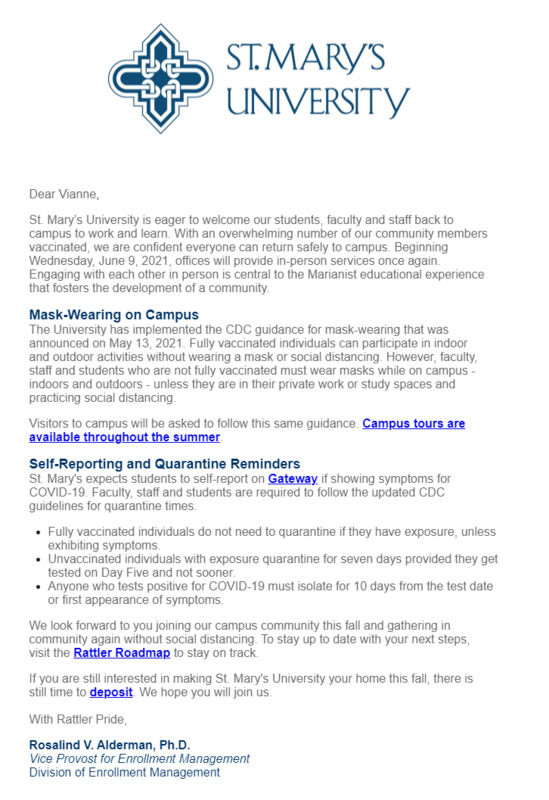
2021-06-08
With the distribution of the vaccine everyone thought things were going back to normal. The pandemic seemed like it was coming to a close. Institutions were beginning to lift the indoor mask-wearing requirements for vaccinated individuals per the CDC's announcement. St Mary's University was one of these of these places. Unfortunately with the rise of the Delta variant St. Mary's had to revoke their decision regarding masks a few weeks later. It was back to "normal" mask-wearing policies no matter what your vaccination status. I, like many others, was disappointed by masks being required again. Too often I had been made late by trying to find a mask to take or even running back to my house or car because I forgot mine. Or ran embarrassed out of a store because I forgot to wear one the entire time I was shopping. I also missed putting on makeup below my eyes, a ritual that helped me feel more put together. They're simple, silly reasons for not wanting to wear a mask anymore but to me they represented normalcy.
-
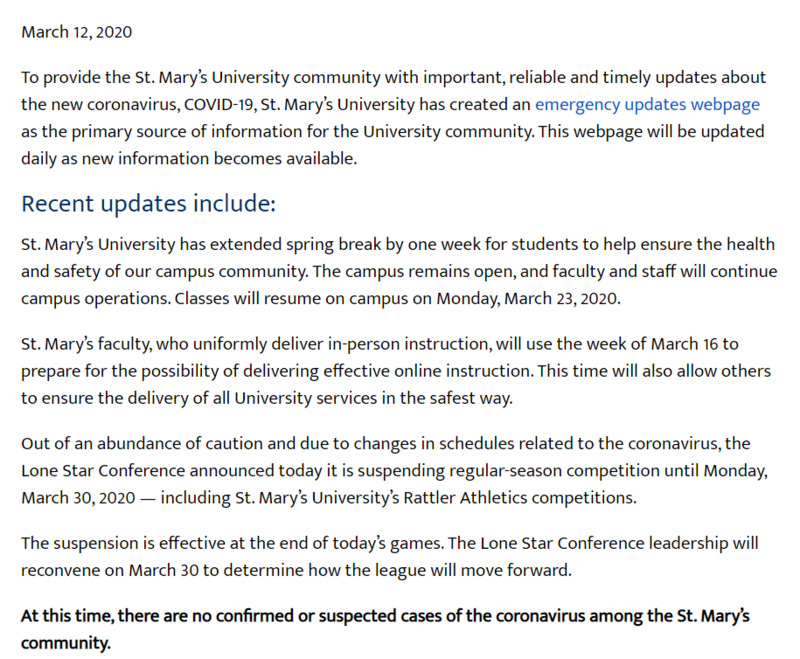
2020-03-12
This image shows how much almost everyone underestimated the pandemic. It also highlights the uncertainty it brought. Most thought we were just getting one extra week of staying home. We would be heading back to campus after that so we were grateful for the extra vacation time. Little did we know that there would be no end in sight for this pandemic for almost two years. No one knew how long it would last or exactly how much it would affect our everyday lives. Procedures constantly changed as institutions tried to figure out the best way to respond to this unprecedented situation.
I think this image would spark student memories of the reaction they had to similar school announcements. Many people were on vacation and came home to a total shift in society like panic buying. My family was in Mexico at the time and in the middle of the vacation the hotel switched from open buffet and people roaming to encouraging people not to interact with others. Before my family left my stepdad had bought some nonperishables to store. I didn't know why he did this and thought this was silly and just a habit from his Red Cross responder days. It turns out he was correct in predicting people would flock to the stores once institutions started practicing preventive measures. This image is just one of the many that demonstrate how people's lives began to change during this time.
-
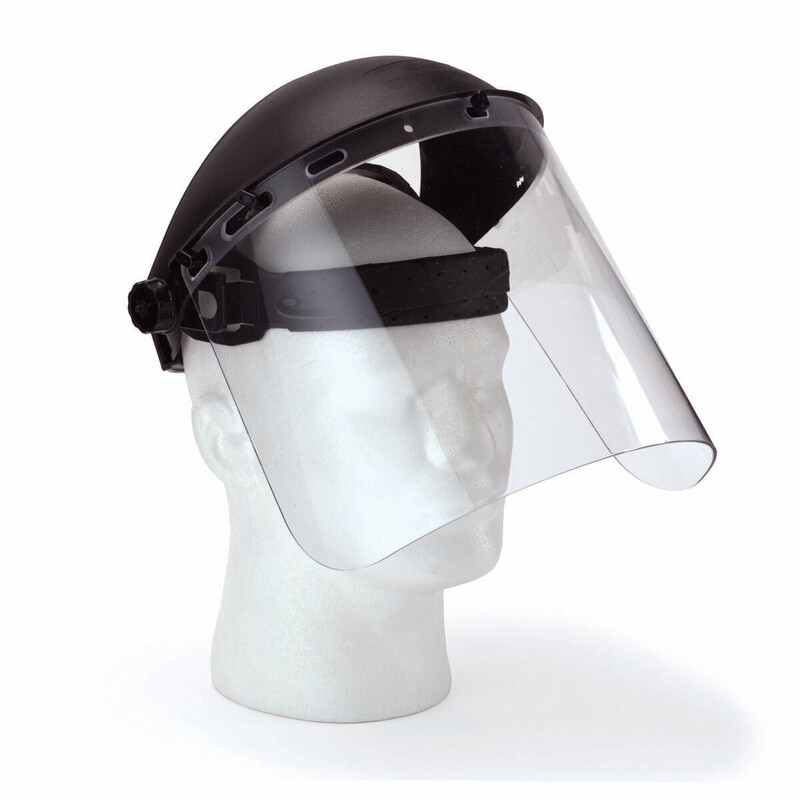
2021-10-14T19:40
I personally worked as a COVID 19 screener for South Texas Veterans Affairs. During that time we as COVID screeners were required to wear face shields and masks on our face for more than eight hours a day. After reading the article I posted from the CDC -- it now does not seem like it was a requirement at all for health workers to wear the face shields. I preferred to wear the ones that were much lighter. They were also face shields, but they were not in a shape of a helmet, they were lighter, and easier to handle as we screeners went from one job station to another. During the pandemic, while employed as a COVID 19 screener-- if we were caught without wearing the helmet (face shield) our jobs were threatened. We were only allowed to take the face shields off intermittently, for example, while at lunch.
-
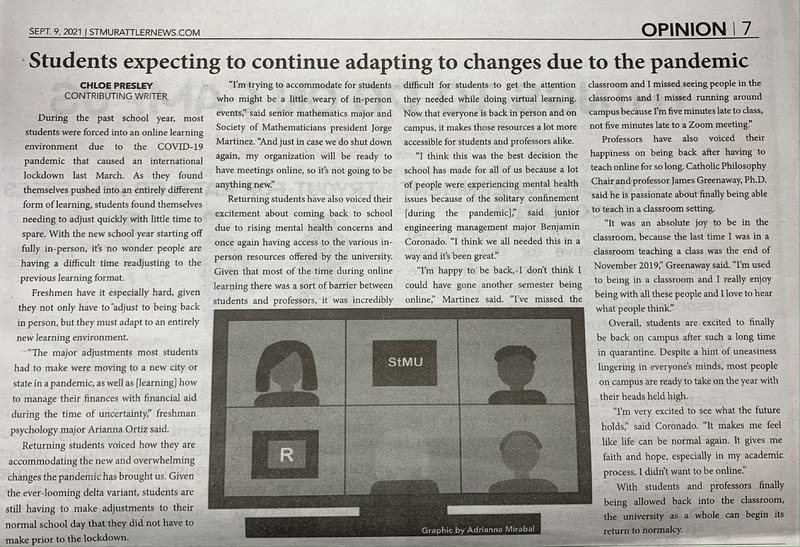
2021-09-09
These text stories are from St. Mary University's Rattler Newspaper. These articles relate to the pandemic and my theme because they are discussing how students are adapting from the previous year(s), whether it be dealing with changes to online vs. in-person lectures, new policies to promote safety, or anything else. This theme is important to me because I was still in high school during the start of the pandemic, so I had to go through lots of adaptations, not only because of my transition into college but also because of the ongoing pandemic. When I decided to attend St. Mary's, lots of things were still uncertain, for example, whether or not class will be held in person or virtually, mask and vaccination mandates, etc. Chloe Presley is the contributing writer, and Adrianna Mirabal is responsible for the graphics.
-
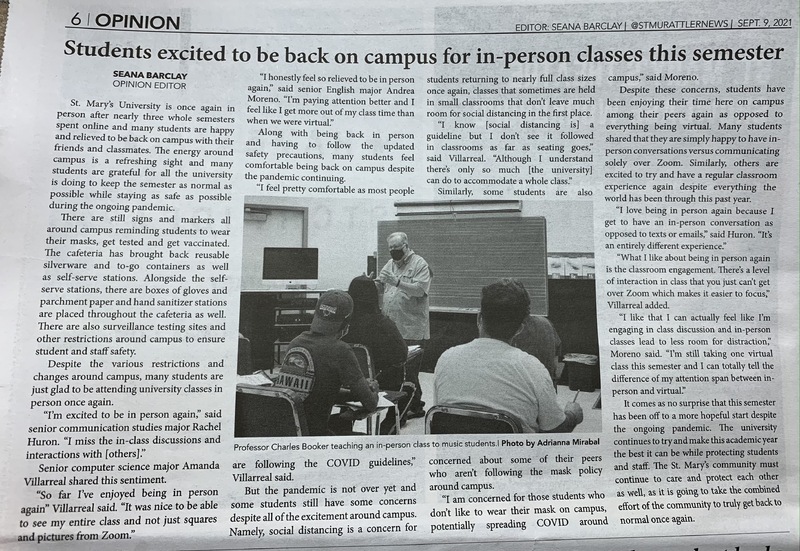
2021-09-09
These text stories are from St. Mary University's Rattler Newspaper. These articles relate to the pandemic and my theme because they are discussing how students are adapting from the previous year(s), whether it be dealing with changes to online vs. in-person lectures, new policies to promote safety, or anything else. This theme is important to me because I was still in high school during the start of the pandemic, so I had to go through lots of adaptations, not only because of my transition into college but also because of the ongoing pandemic. When I decided to attend St. Mary's, lots of things were still uncertain, for example, whether or not class will be held in person or virtually, mask and vaccination mandates, etc. The opinion editor is Seana Barclay and the photographer is Adrianna Mirabal.
-
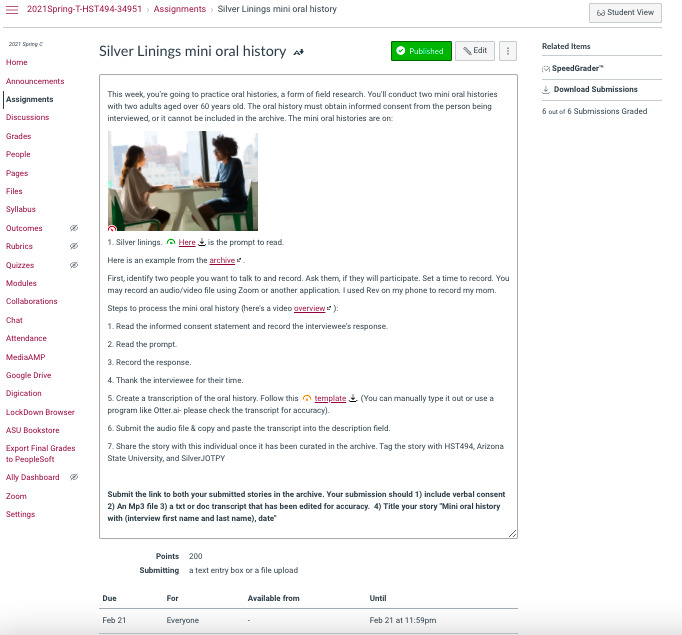
2021-02-21
This week, you're going to practice oral histories, a form of field research. You'll conduct two mini oral histories with two adults aged over 60 years old. The oral history must obtain informed consent from the person being interviewed, or it cannot be included in the archive. The mini oral histories are on:
christina-wocintechchat-com-LQ1t-8Ms5PY-unsplash.jpg
1. Silver linings. Here is the prompt to read.
Here is an example from the archive (Links to an external site.).
First, identify two people you want to talk to and record. Ask them, if they will participate. Set a time to record. You may record an audio/video file using Zoom or another application. I used Rev on my phone to record my mom.
Steps to process the mini oral history (here's a video overview (Links to an external site.)):
1. Read the informed consent statement and record the interviewee's response.
2. Read the prompt.
3. Record the response.
4. Thank the interviewee for their time.
5. Create a transcription of the oral history. Follow this template. (You can manually type it out or use a program like Otter.ai- please check the transcript for accuracy).
6. Submit the audio file & copy and paste the transcript into the description field.
7. Share the story with this individual once it has been curated in the archive. Tag the story with HST494, Arizona State University, and SilverJOTPY
Submit the link to both your submitted stories in the archive. Your submission should 1) include verbal consent 2) An Mp3 file 3) a txt or doc transcript that has been edited for accuracy. 4) Title your story "Mini oral history with (interview first name and last name), date"
-
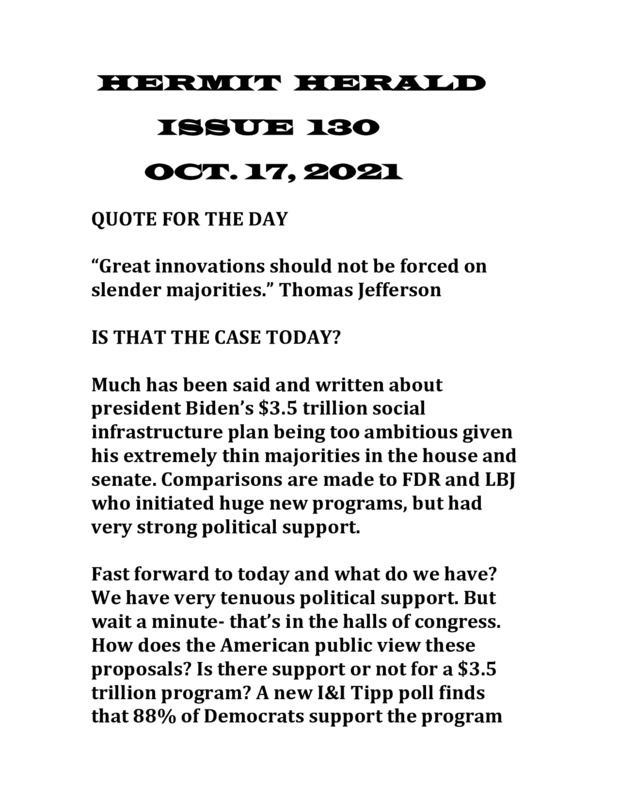
2021-10-17
$3.5 TRILLION BILL, YES OR NO
-
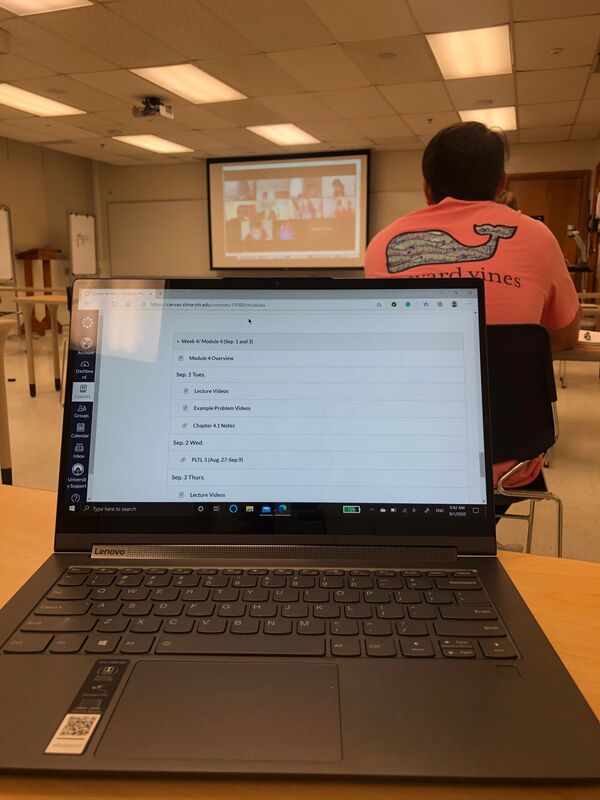
2020-09-01
Classes in Fall 2020 were either fully virtual or hybrid. In hybrid classes, the professors would have to put the projector with some students being on zoom. This was a good idea because it helped students be safe and at the same time learn. It was also challenging because sometimes professors would pay more attention to the students that were in the classroom and not the ones on zoom. I took this picture a year ago to show my parents how classes were working. This was something my parents appreciated because they saw that St. Mary’s University was using all their resources to help students continue their studies. They liked seeing me continue my college experience in a different way but not fully virtual. I saved this picture for over a year to see the changes the world was going to have during the pandemic. I am glad we are finding new solutions and making changes with still being careful with COVID-19 guidelines.
-
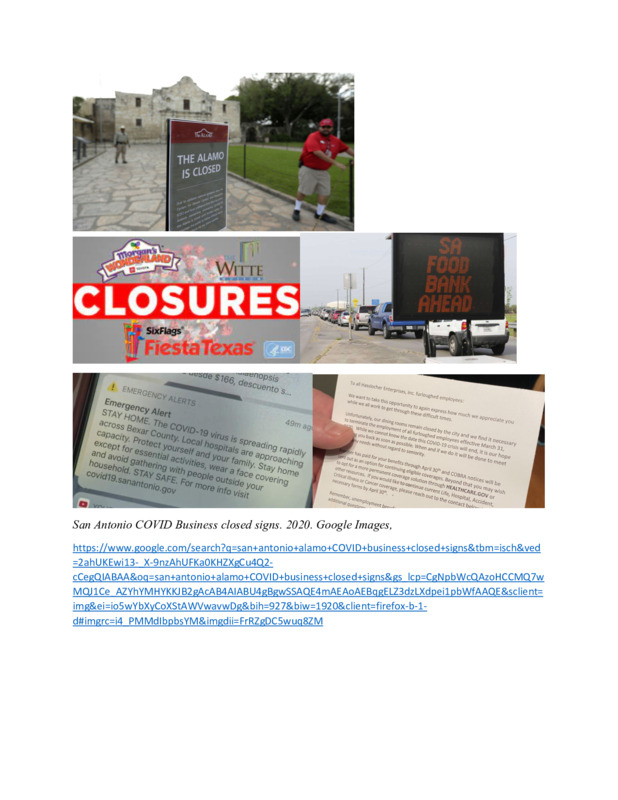
2021-10-14
I want to begin that looking through google website I found some interesting images that went well with what I believe are very important reminders of how and when the pandemic just hit San Antonio. This is important to me because it is a reminder of when businesses/schools were closing and people were losing their jobs and being furloughed had no clue where this pandemic was taking us and so many people lost their homes, no way to put food on tables, or pay bills, etc. Not knowing if we would ever come back to the job we once had and relied on for many years a change that no one knew how it would impact our lives dramatically. For me personally at my employment when I received an email that they will soon let people go from their jobs or furloughed I was worried out of my mind, and a constant thought, of “What will I do if I lose my job.” Something like this can never be forgotten and is a reminder of how our lives can change due to a pandemic that no one ever thought would ever happen and not even prepared for.
-
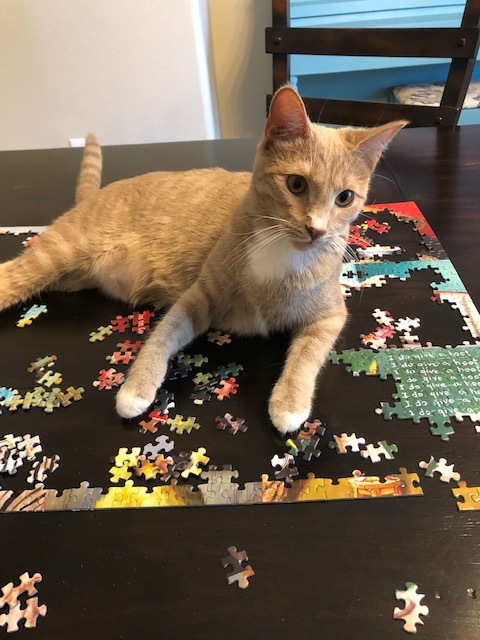
2020-04-25
So many things about the pandemic has been (and continues to be) traumatizing and negative and irritating. But looking back through my phone I saw a photo from the first puzzle I did in April 2020, and then the first photo of our Pandemic Pet, Sunny, from October of that year. So, instead of focusing on the disruptions, today I will focus on two good things from the pandemic. Putting together puzzles has been a fun, stress-relieving activity for me, and I continue to have a puzzle going on our rarely used table even if our lives are back to full busy mode. So that is a hobby I picked up during the pandemic that I can see continuing long into the future. Also, the kitty has brought fun and cuddles to our family, and we all love her (except, perhaps, the dog). Getting a cat was not on our radar until we were locked down and sad. So, for now, I am thankful for puzzles and kitties.
-
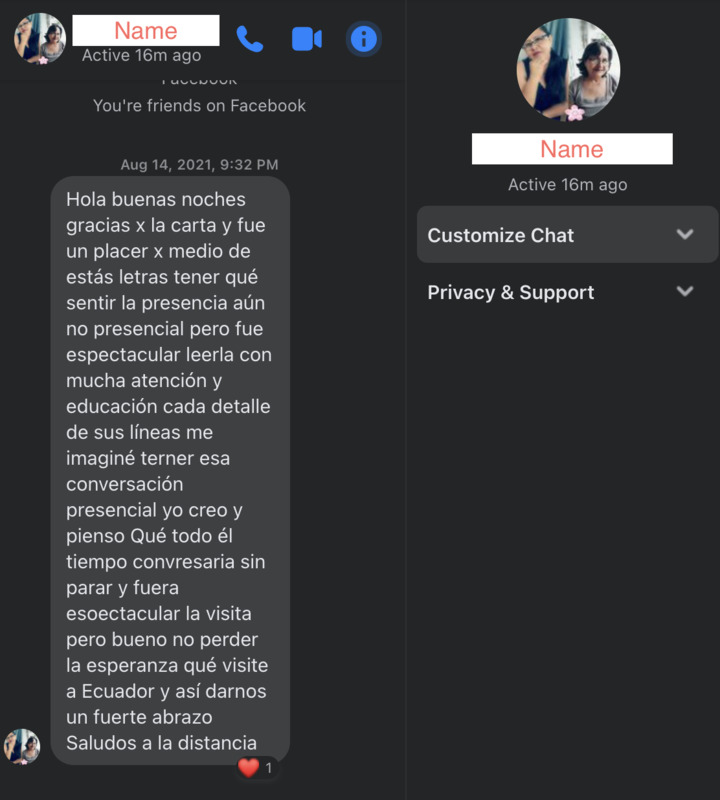
2021-08-14
When being part of the program Empower: Ecuador at my school, we were preparing ourselves to travel to Guayaquil, Ecuador to be present with the families in the community. The families in the community were called our neighbors. Prior to traveling and meeting families in person, each person from the class was given a bookmark with a picture of a neighbor and a brief description of who they were. We were supposed to pray for the person selected and have him/her in our hearts until we meet them in person. Due to COVID-19, we were never able to meet these people whom we felt very close to and it was very sad. Therefore, we were tasked with the beautiful idea of writing letters to them about our prayers and best wishes for them in times of trouble. After a couple of months, I received a message through Messenger, and to my surprise, it was the person I wrote the letter to. She was thanking me for the letter and for how happy she felt when she received it. Also, she shared the desire to get to know me more through social media. It was a beautiful moment and proof of how we could connect with each other despite the social distance. To express this story I am sharing a screenshot of a conversation through Facebook (messenger) with a neighbor from Guayaquil, Ecuador. She is telling me that she received the letter I sent and how grateful she is for it.
-
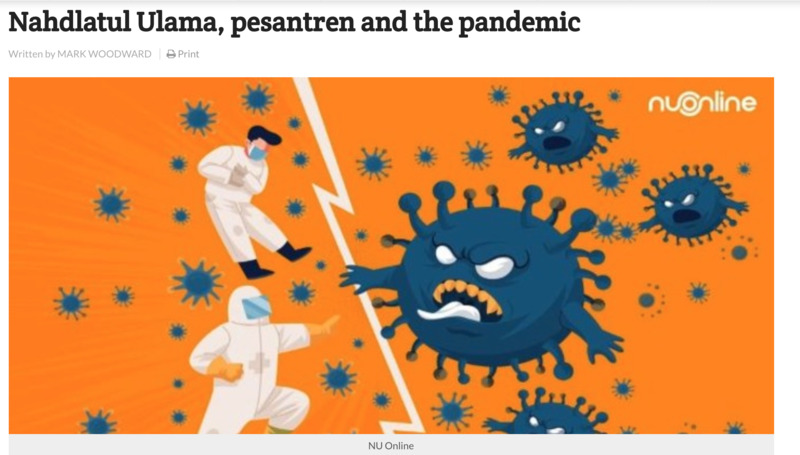
2020-04-23
Nahdlatul Ulama (NU) is the world's largest Muslim organization. This article describes it's efforts to counter the COVID-19 pandemic.
-
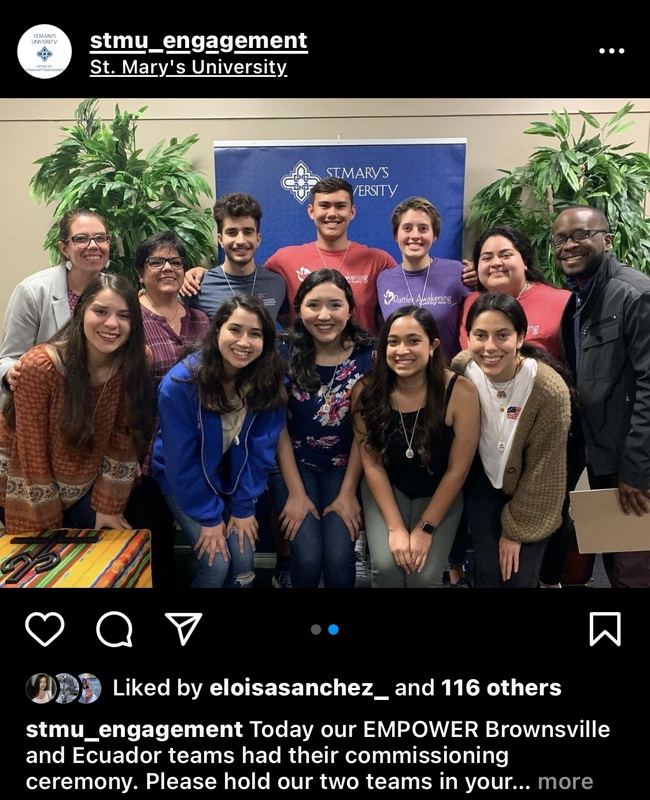
2020-03-15
I was part of the group of student that was preparing themselves emotionally, spiritually, and physically to go to Ecuador and be present with a community in Guayaquil. During this class and for the entire semester we were in retreats together, reading, journaling, and sharing our hearts with each other. We built a community and were deeply connected with the mission of the program and the desire to go to Ecuador and meet the neighbors. However, exactly a couple of days before traveling the lockdown happened, and the plans were canceled. We did not know that the world was going to change so suddenly and immediately. I clearly remember the meeting we had to announce that the trip was canceled and how most of us were filled with sadness and crying. Afterward, we kept being in connection to Ecuador with our prayers and writings. We even wrote some letters to our neighbors in Ecuador. So, this story is to reflects how we can be in connection and engagement with others even during times of depression and distance and how in specific this program had to adapt through COVID-19. To express the story I chose the screenshot of an Instagram post from the Community Engagement Office at St. Mary's University.
-

2020-04-30
This article describes the ways in which the Indonesian Muslim Muhammadiyah organization responded to the onset of the pandemic.
-
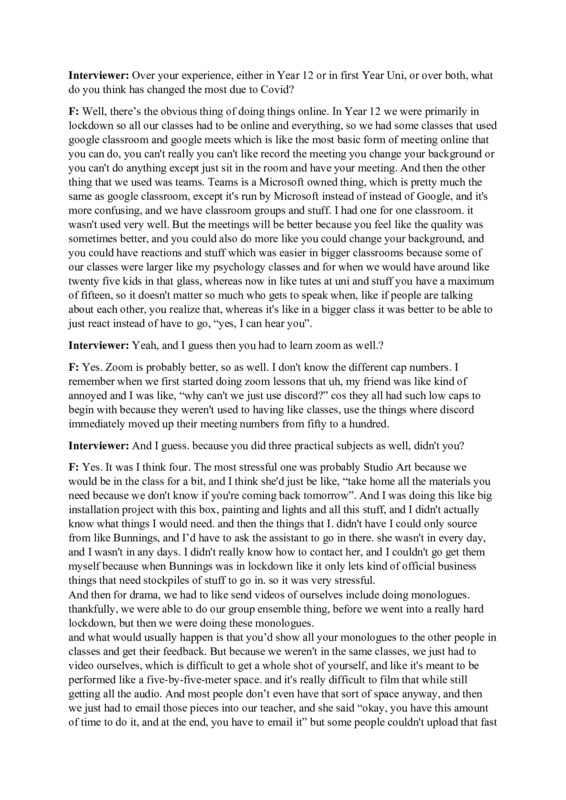
2021-10-15
I interviewed my younger sibling, 'F', and transcribed the audio. They completed Year 12 in 2020 and then began university in 2021, which I believe is a significant transitionary time especially in the context of Covid to document. Their experiences in using different media forms for online classes is insightful and provides an interesting comparison. Additionally they provide insights into changing interests, socialising online, and reflecting on the world around them. They reflect on how they believe the nature of people has changed in relation to each other in an isolated but connected world, which I believe will be an interesting and informative insight for the future to gain an indepth understanding of the Covd-19 era from the perspective of the youth.
-
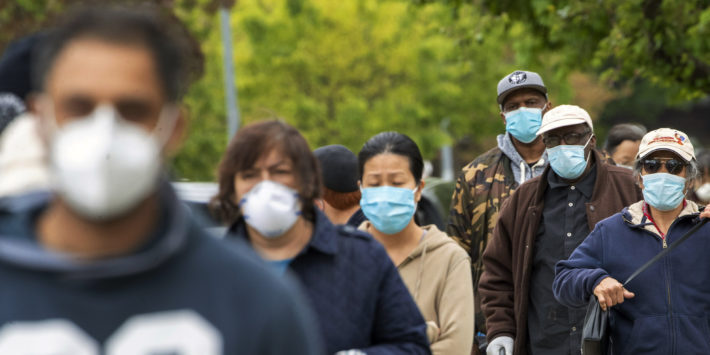
2021-10-18
The mask has had a huge impact on our sense of touch and smell. For one, breathing with a mask on was an adjustment. Tuna sandwiches became something to avoid at all costs because of the smell you could be stuck with all day by wearing a mask. There is also something to say about the feeling of a mask around your ears and over your nose. The constant practice of grabbing a mask and putting it around one's ears has become a ritual of protection or habit as we are now bound to this object like that of a cell phone which is now always on our person. The sense of touch also adapted to various kinds of masks that were promoted and the variety of masks that would be marketed for commercial value. The mask, one of the few things that forces us to run back inside the house because we forgot it. The mask, a true measuring stick for how quick we can adapt and change society for better and for worse.
-
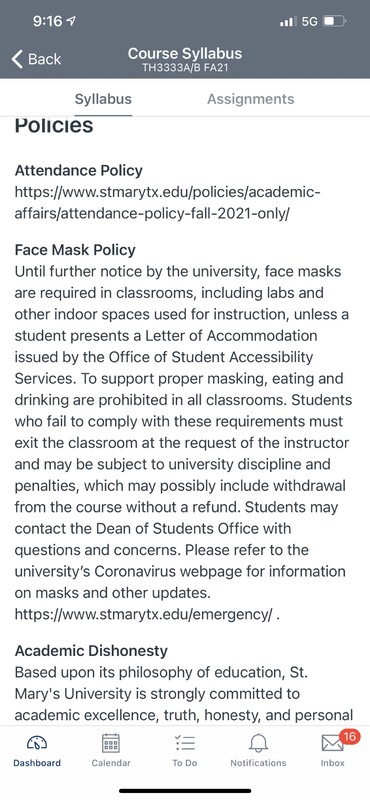
2021-08-17
This is a screenshot of my theology class syllabus including the newly included "face mask policy." I think this is important to include because even though all professors need to include the same information about mask policies, there are some who have just included what needed to be and other who have mentioned it in other areas of their syllabus. It's also interesting to see that this could be the first major change made to some of the professor's syllabi in some time. I submitted this item because it's a part of people's reaction to this pandemic and it heavily influenced changes in our "first-day of class routine." Coming back to school in-person after a whole year online, it was interesting to see how professors were now sharing more personal details about why they are being more careful, checking that students are wearing masks correctly, and some professors being more strict or lenient with the food/drink policy.
-
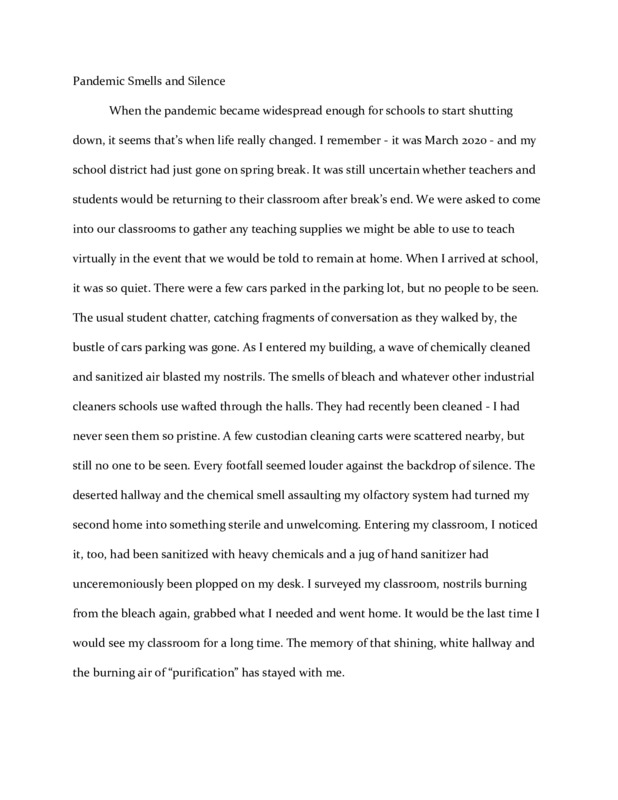
2020-03-19
When the pandemic became widespread enough for schools to start shutting down, it seems that’s when life really changed. I remember - it was March 2020 - and my school district had just gone on spring break. It was still uncertain whether teachers and students would be returning to their classroom after break’s end. We were asked to come into our classrooms to gather any teaching supplies we might be able to use to teach virtually in the event that we would be told to remain at home. When I arrived at school, it was so quiet. There were a few cars parked in the parking lot, but no people to be seen. The usual student chatter, catching fragments of conversation as they walked by, the bustle of cars parking was gone. As I entered my building, a wave of chemically cleaned and sanitized air blasted my nostrils. The smells of bleach and whatever other industrial cleaners schools use wafted through the halls. They had recently been cleaned - I had never seen them so pristine. A few custodian cleaning carts were scattered nearby, but still no one to be seen. Every footfall seemed louder against the backdrop of silence. The deserted hallway and the chemical smell assaulting my olfactory system had turned my second home into something sterile and unwelcoming. Entering my classroom, I noticed it, too, had been sanitized with heavy chemicals and a jug of hand sanitizer had unceremoniously been plopped on my desk. I surveyed my classroom, nostrils burning from the bleach again, grabbed what I needed and went home. It would be the last time I would see my classroom for a long time. The memory of that shining, white hallway and the burning air of “purification” has stayed with me.
-

2021-04-03
Here is a screenshot of a medical appointment reminder for a psychologist in regional Victoria. I had been seeing this psychologist for a few years at this point, however, during the pandemic only telehealth or phonecall appointments were available. These were stressful experiences to conduct these online and finding a safe, quiet space in my house was difficult. That being said, I was lucky to have a psychologist during this period, as I know that many people were not able to recieve adequate care due to the influx of necessity. I chose this appointment reminder specifically as it occurred during the brief reprieve from lockdown early in 2021. It shows how certain health providers (their names have been blacked out for anonymity) have their own unique requirements that must be followed.
-
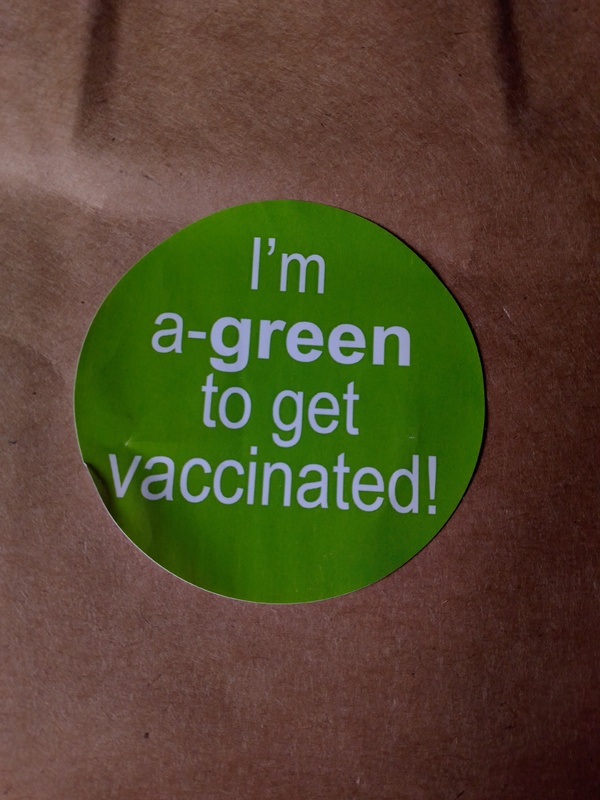
2021-09-20
The image is of a sticker I was presented with upon receiving my first dose of the Covid-19 vaccine, Pfizer. I received my vaccine in regional Victoria and was given the sticker after checking in for my appointment. I was then shown the way to a vaccination booth which was located in the ballroom of a Hotel that had been converted for widespread vaccination. I had been eligible for the Astrazenica vaccine previously in my age bracket, however, I waited until Pfizer was available as there had been less side effects with greater efficacy reported. The vaccines been a contentious issue in the Australian media after delays in our vaccination program and domestic politics overshadowing health advice. These have contributed to a sense of mistrust and paranoia in some.
-

2021-05-10
This is photograph shows one of my dogs, Elfie, sitting next to where I study for university during the pandemic. She and her sister, Bowie, would fall asleep next to me and keep me company. Often, they would help keep me motivated when I was struggling by hassling me back to the table. It is easy to look back over the past two years and look at the negatives, however, it is moments like the one depicted in the picture which help remind me that there were positive moments too.
-
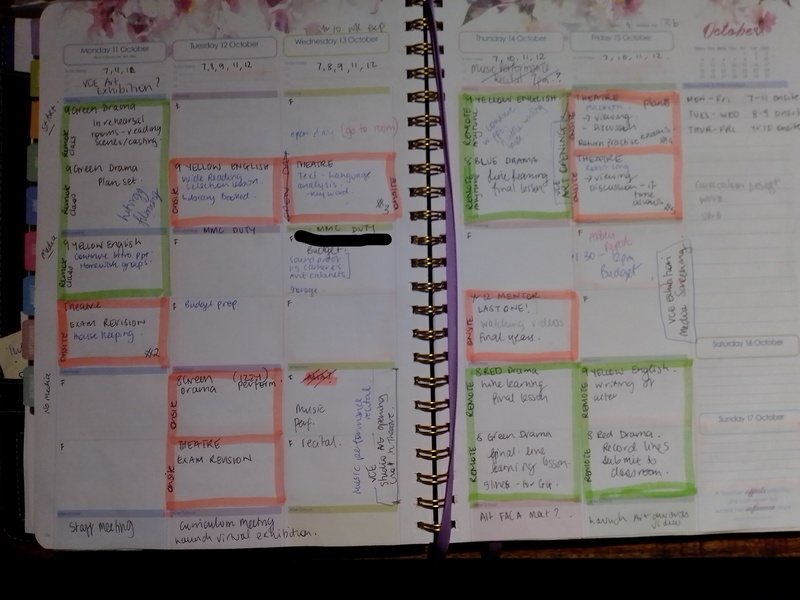
2021-10-11
This is an image of a week from my mother's chronicle. She is a secondary teacher in regional Victoria who primarily teaches Theatre Studies, Drama and English. During the time that the photograph was taken (October 2021), the school she is working at decided to stagger teaching different year levels to reduce the threat of a Covid-19 outbreak in the lead up to VCE exams. As highlighted in the chronicle in different colours, some classes would be taught in-person and others online in one day. As my family does not live in the same town that my mother teaches in, she would often have to stay at school the entire day regardless. Due to the nature of rapid changes in health information and additional directions from the school itself, every week in the chronicle looks very different to the next. The image shows an element of the chaos that is present in the everyday lives of individuals during covid and the ability for plans to rapidly change from day to day.
-
2020-04-01
One thing that captures a sensory memory that relates to the COVID-19 pandemic for me is candles, specifically pumpkin spice candles. My wife and myself, like many other people, spent the majority of 2020 shut inside our home. Prior to this pandemic, we would often go out 3-4 nights a week. Nothing crazy, of course. Dinner, bowling, movie, etc. Typical married couple dates. However, once we were shut inside our house, we had to find other little things to occupy our time so we wouldn’t go stir crazy. My wife started buying a lot of scented candles from Amazon, and her favorite was pumpkin spice. I swear, my apartment smelled like pumpkin spice from about April of 2020 to January of 2021. The scent helped her relax, and it made me happy to know that she was finding ways to keep herself settled and centered. Now, whenever I’m out somewhere and catch a scent of pumpkin, I think of the two of us trapped in the apartment but working together to make the whole experience into a positive. I know that this is probably more of a sentimental story than what we were supposed to write, but this is what first came to my mind when I saw this assignment.
-
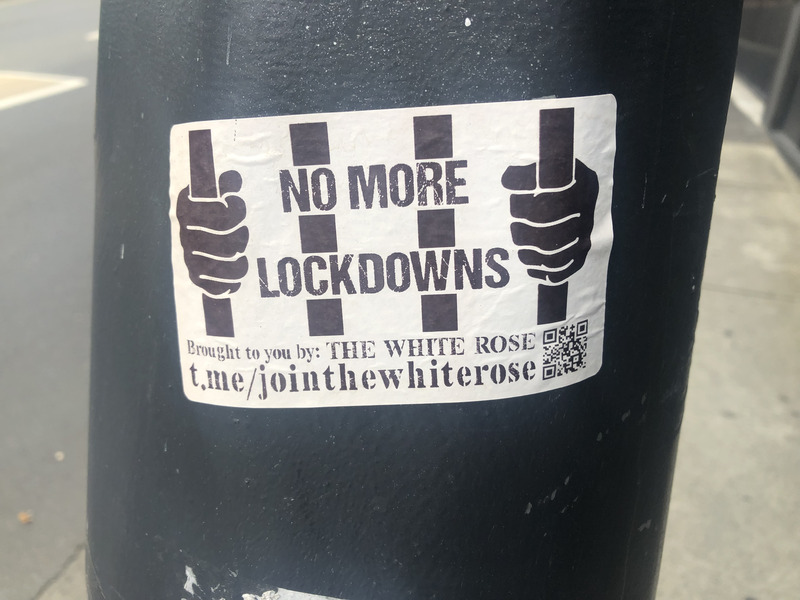
2021-10-01
I found this sticker while I was walking to pick up a click-and-collect order. I was struck by it because of its reference to 'The White Rose', an anti-Nazi movement begun by Sophie Scholl in 1942 Germany. The insensitivity and total misunderstanding of what constitutes oppression is a touchstone to the anti-lockdown and anti-vaxxer movements. It made me wonder how they could appropriate histories of discrimination - do they simply not understand the Holocaust, or do they genuinely believe that their situation is similar to it?
-
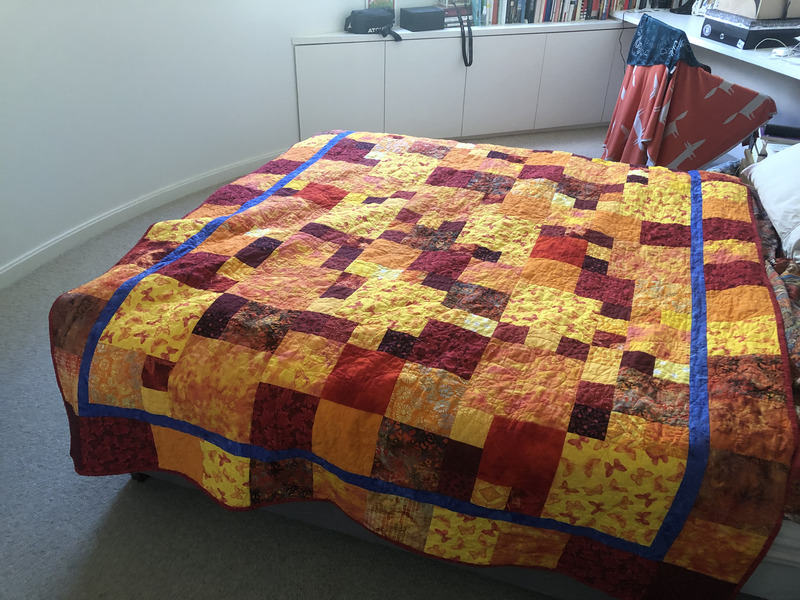
2021-10-13
Last year (2020) I was living at home with my parents. My mum noticed how the pandemic was affecting me mentally and suggested that I make a quilt as a therapeutic tool. It was my first ever quilt, and it took several months. I enjoyed making it so much that I've kept on making quilts ever since. This quilt, therefore, reminds me of the pandemic's silver linings; it forced me to take up a hobby, one that slows me down. This photo is of the quilt on my bed now in Melbourne (2021).
-
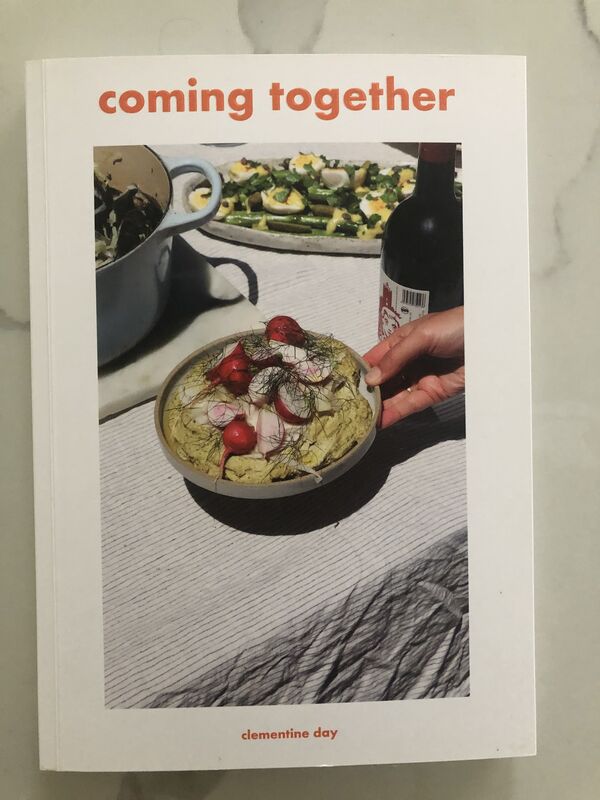
2021-04-13
I bought this cookbook earlier this year from a local Melbourne lady. During the 2020 lockdowns, she decided to write a cookbook celebrating cooking and sharing food with friends during eased restrictions. Whenever I cook from this cookbook, I am reminded of how the pandemic was also an opportunity for many people to pursue new hobbies and interests, often creative ones, that they previously wouldn't have.
-
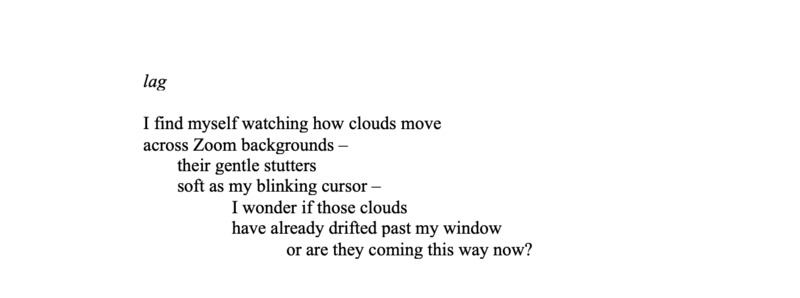
2021-07-16
I began writing poetry last year (2020) since I suddenly found myself with much more time on my hands. I wrote this poem earlier this year when I was in a boring Zoom tutorial. Reflecting on it afterwards, I found the theme of lagging very pertinent for my feelings during the pandemic.
-
2021-10-17
The story and my experience are an example of the many ways in which the pandemic affected individuals in different ways. It goes without saying that each person was impacted in varied ways due to Covid-19, however, not all of them were either explicitly negative or an outcome that is easily defined as being either beneficial or harmful. During the height of the pandemic in the United States, I was employed as an Assistant Warehouse Manager in Green Bay, WI. My workload and responsibilities were already a little taxing, but once things got in full swing with Covid they became even more so. I went from working an average of 60 hours a week to over 75. This was mainly due to about a third (or more) of our employees being out of work due to quarantine-type measures or actual illness. This went on for months at the beginning. Many weeks out of that time period there were as few as about a dozen of us running three shifts in a warehouse that normally employed roughly 40 workers. Also at this time, my wife became unemployed because her place of employment shut down. Others around me were losing their jobs in droves and facing financial hardship. But due to my position and the nature of the job, I had never had more job security and we never faced any kind of financial difficulties. On the contrary, during the entire pandemic, my wife and I never went without or struggled. This gave me a surreal feeling and one that I almost felt guilty for living through. Aside from some minor changes in my daily life, I barely noticed any personal changes due to Covid. All in all, it was an extremely odd time to live through; the pandemic wasn't necessarily bad for my wife and me, but I know it was for countless others. And that made it all the more strange.
-
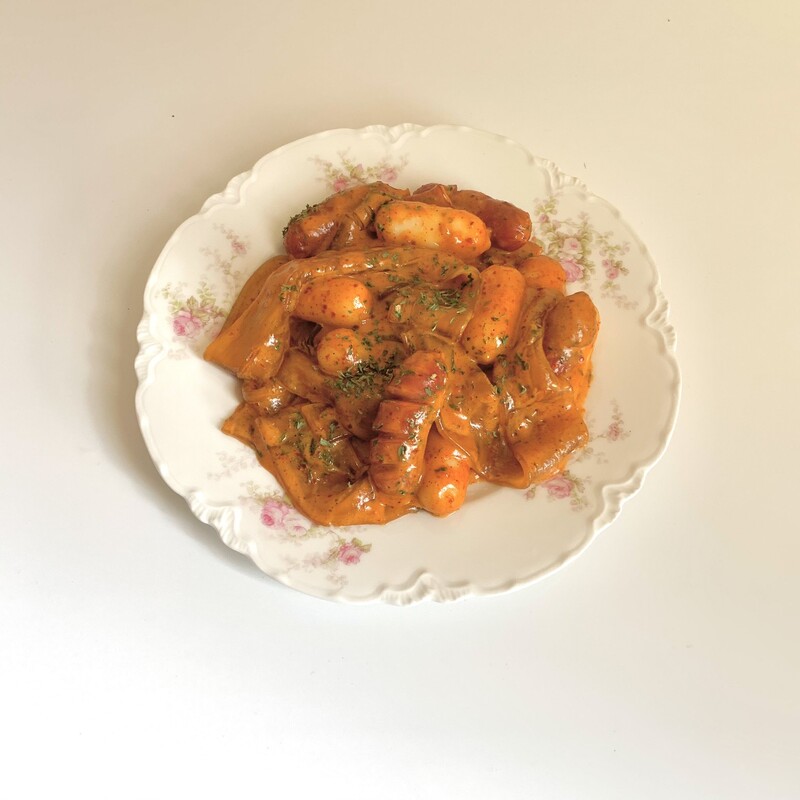
2021-10-17
Amid the COVID-19 pandemic, my favorite pastime was watching various cooking and food story-time videos on YouTube. Yet, there was one video in particular that caught my full wide attention. I remember on May 6th, 2021, at around 10:45 pm PST, this video appeared on my YouTube recommendations. The video thumbnail showed one of my favorite Korean street foods, Tteokbokki (Korean spicy stir-fried rice cakes), but with a new twist!
Growing up, I associated Tteokbokki with flavor notes such as the spiciness of the Gochujang and Gochugaru (Korean chili paste and chili powder), the sweetness of the Mulyeot (Korean corn syrup) in which also helps give the rice cakes its glossy shine, as well as using Sogogi dashida (Korean beef stock powder) to further enhance the umami tangy flavor. Of course, there are other variations of Tteokbokki such as Jjajang Tteokbokki (made with Black bean paste) and Gungjung Tteokbokki (made with both Soy sauce and beef) but the modern recipe with the Gochujang never failed to hit all my tastebuds. Well, that was until I discovered the video.
The video used the modern Tteokbokki recipe, but also adding in a new twist with ingredients such as heavy cream and milk to give the Tteokbokki a pink color. Because the Tteokbokki resembled the pink colors of a Rose pasta sauce, it became “Rose Tteokbokki.”
After watching the video and doing some research on Rose Tteokbokki (I ended up staying up till 3 am) I became convinced and made some for brunch.
Making Rose Tteokbokki for brunch was the best decision I ever made because it still kept the delicious flavor notes of the modern recipe but with the extra creaminess and cheesiness thanks to the heavy cream and milk. Also, adding in meats such as sausages and bacon along with Korean wide glass noodles gave the Rose Tteokbokki a unique chewy texture combo.
Once I finished up the Rose Tteokbokki, I posted a picture of the Rose Tteokbokki on my social media accounts, and one of my friends who live in Seoul replied with, “Jungeun! You’re also joining the Rose Tteokbokki bandwagon?! Everyone in Korea is rushing to make their own and/or ordering from the delivery apps because of Covid! Once Covid ends, come visit me and let’s eat Rose Tteokbokki together!” Reading my friend’s response left me with a big smile on my face, and it felt great to connect with the motherland even without physically being there through Rose Tteokbokki.
-
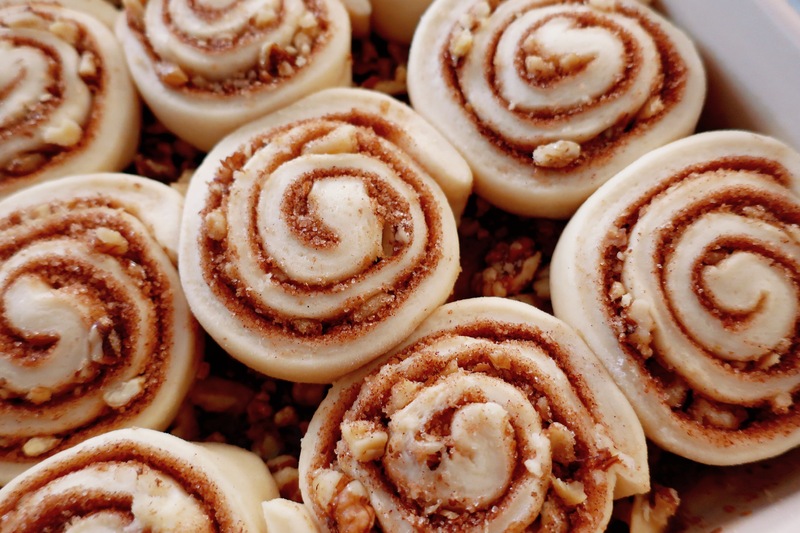
2021-09
One of the most defining characteristics of my quarantine has been learning how to bake. After a year and a half, I am finally comfortable kneading, proofing, and baking. I have learned the tell-tale signs of under-proofed and over-proofed bread by touch (slightly indent the bread with the end of your finger and how the dough springs-back will tell you all you need). I have learned to listen for the hollow sound of fully cooked bread. However, one of the greatest joys I have found with baking is filling the house with the smell of cinnamon, sugar, and cardamom on a Sunday morning with my slightly adjusted cinnamon roll recipe from our well-used Betty Crocker’s 1961 New Picture Cookbook (it was my mum’s before me).
My family is Scandinavian, and the smell and taste of cardamom is ever-present in Scandinavian baking. Kanalsnegl, klejner, and fødselsdagboller are all delicious Danish and Norwegian cardamom classics. But Betty Crocker’s cinnamon rolls are also highly popular in my house. From this, a fusion roll was born. On Sunday mornings, the house is filled with cinnamon and cardamon of these classic buns. The Betty Crocker recipe calls for two teaspoons of cinnamon filling, but I sub one teaspoon with cardamom. I also add a pinch of cardamom to the butterscotch topping.
In a time of stressful uncertainty, the smell of freshly baked rolls with cinnamon and cardamom is like wrapping up in a comfortable blanket. I have attached the recipe if you want to try this sensory smell experience, too.
-
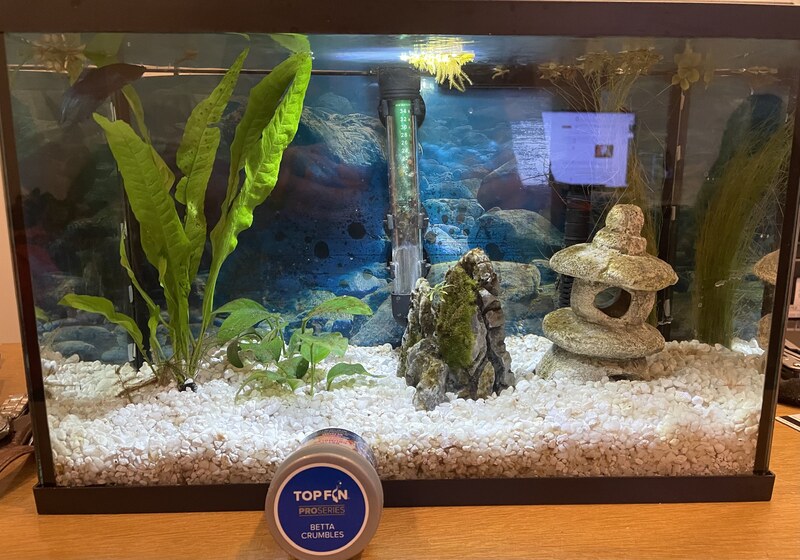
2021-10-17
Since the Pandemic began and I was moved to remote work I have been spending more time than ever in my apartment. I bought some house plants to liven up my humble abode but they are easy to care for and don't do too much other than exist. I was looking to get a pet to occupy some of my time but unfortunately my building does not allow for cats or dogs, so I went for a fish friend as the lease was ambiguous towards fish. In college my roommate had two fish tanks and cared for them very well. The fish were always big hits with house guests and caring for them seemed easy enough. It was with this in mind that I purchased a male betta fish, which I named Tarzan after the drug smuggler Ludwig Fainberg from the documentary "Operation Odessa" which I highly recommend. However caring for a betta fish is not as simple as I initially thought. Yet with the help of the internet and all its wisdom I was able to do enough research and find exactly what I needed to make my tank as comfortable as possible for Tarzan. I purchased a five gallon tank along with, a filter, a heater (betta fish like it warm), gravel, a background poster, a pagoda, live plants, a net, a gravel pump for cleaning, ph chemicals, a large moss rock and of course fish food. He gets fed twice a day, once in the AM and once in the PM. The tank needs to be cleaned at least once a month and the filter is changed during that process as well. Every time I crack open his food my nose is greeted by a distinct fish food smell that is unmistakable and equally unpleasant. While I do not think that it would be impossible to care for Tarzan if I was still going into the office every day, it is definitely easier now that I am home more often. Cleaning the tank takes about an hour and can get smelly at times depending on how long it has been since its last cleaning. Without the current work from home situation brought on by the pandemic I would not have considered owning any type of pet that I would have to care for on a daily basis. The average lifespan of a betta fish is between three to five years, hopefully with enough care Tarzan can live to the full five and see the other side of the pandemic.
-
2020-05-03
In the part of Maryland I live in, there is a lot of noise pollution caused by cars and planes. On one side there is a large international airport, a busy road on the other and a large highway on the third side. Almost every day, the sound of cars, planes and the occasional helicopter can be heard. However when the COVID19 pandemic began to pick up pace, lockdowns were set up in an attempt to slow its advance. While the affect of this was seen in large empty parking lots at the airport, it could also be heard. The roads were quiet, as less people went out to shop, see family or go out to eat. In addition with very few people traveling, the daily noise of airplanes declined significantly. Everything became far quieter and a reminder of the lockdown, a constant reminder that we were going through a major event in world history. However while the quiet brought about by the lockdowns was a reminder of the pandemic, the return of noise was just as much a reminder. When planes and particularly cars started to create more noise pollution, it showed that even with a global pandemic and lockdowns, it wasn't going to stop people from going out.
-
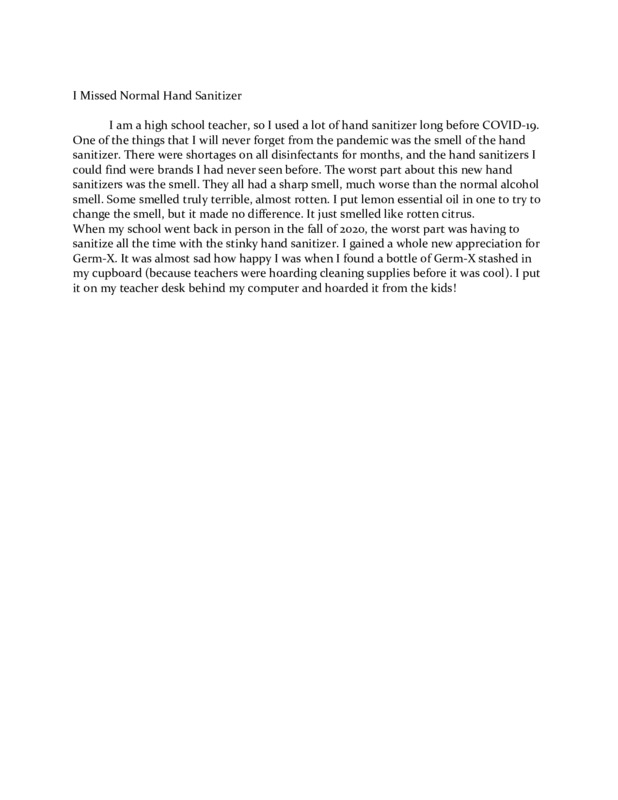
2020-08-15
I am a high school teacher, so I used a lot of hand sanitizer long before COVID-19. One of the things that I will never forget from the pandemic was the smell of the hand sanitizer. There were shortages on all disinfectants for months, and the hand sanitizers I could find were brands I had never seen before. The worst part about this new hand sanitizers was the smell. They all had a sharp smell, much worse than the normal alcohol smell. Some smelled truly terrible, almost rotten. I put lemon essential oil in one to try to change the smell, but it made no difference. It just smelled like rotten citrus.
When my school went back in person in the fall of 2020, the worst part was having to sanitize all the time with the stinky hand sanitizer. I gained a whole new appreciation for Germ-X. It was almost sad how happy I was when I found a bottle of Germ-X stashed in my cupboard (because teachers were hoarding cleaning supplies before it was cool). I put it on my teacher desk behind my computer and hoarded it from the kids!
-
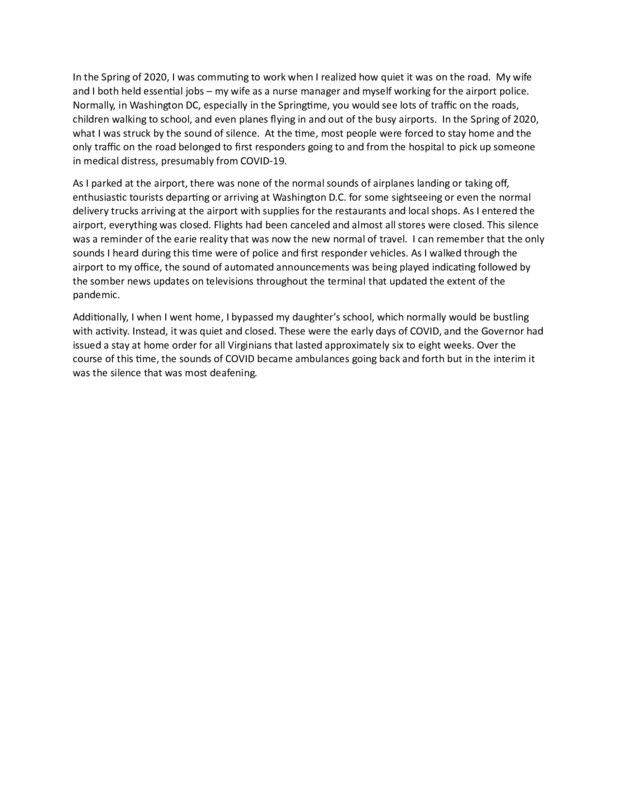
2020-03-15
My story is about the absence of sound during the pandemic.
-

2021-03-14
The COVID-19 pandemic has brought about many paradigm shifts; everyone I know has undergone a lot of change in themselves, their beliefs, and in how they view and interact with the world. There is a lot of grief these days but there are changes worth being happy about.
-
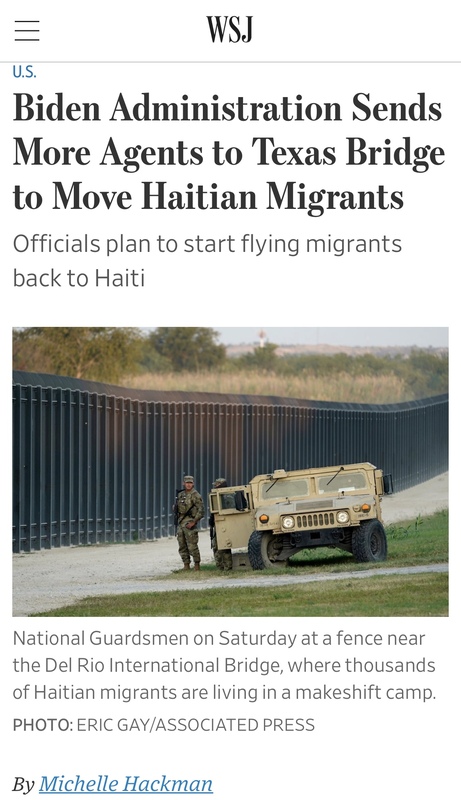
2021-09-18
It is utterly dismal that this is taking place, and being written about, as if it were compartmentalized from the crisis of mass death facing the entire planet. Face masks are required on all U.S. public transit and on all flights, yet migrants seeking asylum are treated without regard for even their bare minimum safety.
 2020-03-24
2020-03-24 2021-10-01
2021-10-01 2021-08-24
2021-08-24 2021-09-07
2021-09-07 2021-10-07
2021-10-07 2021-09-10
2021-09-10 2021-10-27
2021-10-27 2021-10-27
2021-10-27 2021-10-27
2021-10-27 2020-08-11
2020-08-11 2020-08-11
2020-08-11 2021-08-02
2021-08-02 2021-08-09
2021-08-09 2021-06-11
2021-06-11 2021-06-08
2021-06-08 2020-03-12
2020-03-12 2021-10-14T19:40
2021-10-14T19:40 2021-09-09
2021-09-09 2021-09-09
2021-09-09 2021-02-21
2021-02-21 2021-10-17
2021-10-17 2020-09-01
2020-09-01 2021-10-14
2021-10-14 2020-04-25
2020-04-25 2021-08-14
2021-08-14 2020-04-23
2020-04-23 2020-03-15
2020-03-15 2020-04-30
2020-04-30 2021-10-15
2021-10-15 2021-10-18
2021-10-18 2021-08-17
2021-08-17 2020-03-19
2020-03-19 2021-04-03
2021-04-03 2021-09-20
2021-09-20 2021-05-10
2021-05-10 2021-10-11
2021-10-11 2021-10-01
2021-10-01 2021-10-13
2021-10-13 2021-04-13
2021-04-13 2021-07-16
2021-07-16 2021-10-17
2021-10-17 2021-09
2021-09 2021-10-17
2021-10-17 2020-08-15
2020-08-15 2020-03-15
2020-03-15 2021-03-14
2021-03-14 2021-09-18
2021-09-18